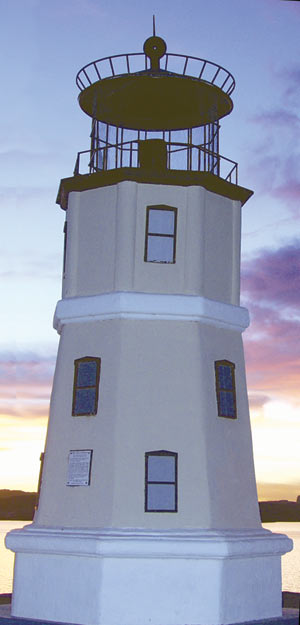 March
2006
March
2006
Lighting The Way On Lake Havasu
 Photo
by Lake Havasu Lighthouse Club Photo
by Lake Havasu Lighthouse ClubLIGHTING THE WAY -- A community comment over six years ago was "We need to get lights out there on that lake." Consequently, friends Bob Keller, John Walker, Jack Meredith, and others formed a volunteer organization known as the Lake Havasu Lighthouse Club. Their mission: to light the way on Lake Havasu for the safety of boaters. In 2006, there are nearly 12 completed lighthouses, among them the pictured Split Rock4 Broch. By Karen Scanlon The night was dead black. Not a star visible. No silver water to guide them. It left an edge to an otherwise playful day for six Lake Havasu City residents who had gone to Havasu Springs for a day of golf and dinner. But, navigating homeward on dark water stirred an eerie, unsettling feeling. "We need to get lights out there on that lake," they said the next day. That was six years and nearly 12 lighthouses ago. Friends Bob Keller, John Walker, Jack Meredith, and others, gathered to form a volunteer organization known as the Lake Havasu Lighthouse Club. Their mission: To light the way on Lake Havasu for the safety of boaters. "Prior to our lighthouses, we had five or six navigational lights on the lake, but they weren’t very bright and hard to identify mixed into the developed shoreline," Walker says. So, the group began building lighthouses — not just any old lighthouses, but scaled-down replicas of real ones. First up, Cape Hatteras, a 45-foot round pyramidal tower with the distinctive black and white spiral. Vivid patterns painted on lighthouses are intended as day marks. The beacon stands at the personal watercraft ramp of Windsor State Park and flashes a rotating amber light every second. "After this thing got off the ground, we discovered that lights used by the State Park were totally inadequate for our lighthouses, with just half-mile visibility and at a whooping cost of $8000," says Bob Keller, President, Lake Havasu Lighthouse Club. Keller spent more than a year researching a more efficient light source and found the Carmanah Company in British Columbia that produces a compact, longer-lasting light, at the miracle price of $1000. Keller laughs, "I called them and asked, are you for real or are you a scam?" The Club took a chance and bought a light. Today, Lake Havasu’s lighthouses are wired with a later version of that model—a Series 700 Solar-Powered LED Light with a visibility range of up to three nautical miles. These LED (light emitting diodes) lights are packed with solar panels, LEDs, and batteries in a self-contained, sealed unit. A built-in GPS receiver enables the flash synchronization. Operating life span: 100,000 hours. Simply replace the battery every five years. "The lights are colored according to Coast Guard regulation," Keller says. Flashing amber lights indicate the entrance to a marina or safe-harbor. Red beacons are located on the east side of the lake, which borders Arizona, heading north. Green beacons are located on the west, or California side, as you head north. Keller stresses that first and foremost, the lighthouses are navigational aids for safety on the lake. "Coincidentally they look like lighthouses — a fact that has taken more priority than that they are navigational lights," he says. "It’s a very, very busy waterway and we continue to have accidents. We really haven’t put the lights where they are most needed." To date, the lighthouses stand in public places, visible offerings of proud sponsors. However, beacons are needed further along the lake, but people on shore won’t see them. "We’ve identified 35 sites down the winding lake where lights are needed right now," Keller says. "If dreams came true, we’d have a light at every mile, and our jurisdiction is dam to dam, 85 miles." As for the actual construction labor of these appealing replicas, volunteer craftsmen, electricians, and would-be-architects (many of them retired) lend their skill to the lighthouse projects. First, a real lighthouse is chosen and ‘blueprints’ secured. If the replica is to stand on the Arizona side of the lake, it’ll be an East Coast lighthouse; on the California lakeshore, a West Coast lighthouse is selected. "Neil Esmay is the best thing we’ve got," Keller says. "Our master builder!" Esmay is a transplant from Kansas City who started a construction company at Lake Havasu City many years ago. But, Esmay works alongside an entire community that rallies ‘round the cause of safety on the lake, from foundation pouring to local crane operators who lift the finished product onto the site. You have to see these lighthouses to believe them. Members of the Lake Havasu Lighthouse Club have demonstrated innovative and industrious commitment to the local lake area. Hats off, everybody! |